Кошка, часть 2-ая
The generic Russian word for cat is кошка. It declines like this.
| Sg | Pl | |
| Nom | кошка | кошки |
| Acc | кошку | кошек |
| Gen | кошки | |
| Pre | кошке | кошках |
| Dat | кошкам | |
| Ins | кошкой | кошками |
In the US we summon cats with "here, kitty-kitty-kitty." In Russia you summon a cat by saying «кис-кис». In the summer I was at Raifa Monastery and experimented. Sure enough, the cats did *not* respond to the American version, but they immediately responded to the Russian version.
| — Ты любишь кошек? — Люблю. |
“Do you like cats?” “I do.” |
| Кис-кис! Ах, какая ты ласковая! Хочу привезти тебя домой, но мама просто не разрешает. | Here, kitty-kityy! Oh, you are so sweet! I want to take you home, but Mama won't let me. |
| Нашу кошку всегда мучит соседская собака. | The neighbors’ dog is always tormenting our cat. |
| — Где Даша? — Она во дворе играет с кошками. |
“Where is Dasha?” “She's in the courtyard playing with the cats” |
Last summer one of my students was recovering from a laparoscopic procedure in Kazan's Hospital #18. He was horrified to see a cat wandering through the ward. I mentioned that to my friend Flyura, and she just laughed and said,
| В каждой русской больницe есть кошки. Они вообще такие ласковые, что прямо подходят и залазят тебе в сумку. | Every Russian hospital has cats, and they are usually so friendly that they'll just come right up and crawl into your purse. |
Мультфильм
Cartoon or Мультфильм in Russian is an animated show or movie. It declines as such:
| Sg | Pl | |
| Nom | мультфильм | мультфильмы |
| Acc | мультфильм | мультфильмы |
| Gen | мультфильма | мультфильмов |
| Pre | мультфильме | мультфильмах |
| Dat | мультфильму | мультфильмам |
| Ins | мультфильмом | мультфильмами |
| У меня есть мультфильмы из Японии. | I have cartoons from Japan. |
| Мы рассказали о мультфильмах. | We talked about cartoons. |
| Я узнала об этом предмете из мультфильма. | I learned about the subject from the cartoon |
| Она умерла в мультфильме. | She dies in the cartoon.(Translated as a historical present) |
In America there are a lot of animated shows that are for younger audiences such as Winnie the Pooh, Alice in wonderland and many other works by Disney. But there are also cartoon shows for adults that are usually comedy based such as Archer or Venture bros. Every country has its own form of drawing styles and techniques that are represented in the animations that they have or do. Japan has coined the term anime for their productions, many of which have become international. Japanese artist studios collaborated with Russian studios to create the animated film First Squad or Первый Отряд. Cartoons have various elements that real life motion pictures may not be able to express. “The magic of Disney” relies on the animation most of the time to present the wonders it wants to convey. In Japanese culture people are very reserved and most of the time conceal their emotions, however when one watches their anime many of the characters are given various facial expression and exaggerated body language to represent the emotions in a way that cannot be conveyed in real life.

Ласточка
Outside my apartment here in Kazan every morning and evening a flock of swallows flies around catching the twilight bugs. They are swift flying, split-tailed avians. Every once in a while one flies into my balcony through an open window and, confused by all the glass, can't figure how to get back out. I walk up from behind, gently wrap it in my hands and release it through the one open window. The Russian word for swallow is ласточка.
| Sg | Pl | |
| Nom | ласточка | ласточки |
| Acc | ласточку | ласточек |
| Gen | ласточки | |
| Pre | ласточке | ласточках |
| Dat | ласточкам | |
| Ins | ласточкой | ласточками |
A swallow looks like this.

| Вот летит ласточка! | There goes a swallow! |
| — В чём живут ласточки? — В гнёздах, сделанных из грязи. |
“What do swallows live in?” “In nests made of mud.” |
| Питаются деревенские ласточки насекомыми: мухи, кузнечики, сверчки, стрекозы, жуки и другие летающие насекомые составляют 99 % их рациона. (source) | Barn swallows feed on insects: flies, grasshoppers, crickets, dragonflies, beetles and other flying insects make up 99% of their diet. |
| — Ты любишь ласточек? — Люблю смотреть, как они летают по двору, но их чириканье напоминает звук плотоядных птиц из фильма «Чёрная дыра». |
“Do you like swallows?” “I like to watch them fly around the courtyard, but their chirping reminds me of the sound of the carnivorous birds from the movie ‘Pitch Black’.” |
Just as important as the birds themselves in Russia is the chocolate candy named after them, which looks like this.
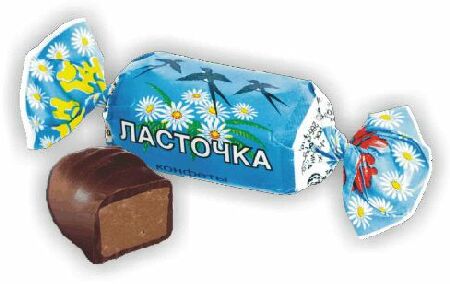
So what is a ласточка?
| Ласточка - это конфета с помадным корпусом, глазированная шоколадной глазурью. | A ‘Lastochka’ is a fondant candy with a chocolate glaze. |
| В «Ласточке» — помада «Крем-брюле» с добавлением какао-порошка, цитрусовой подварки и сливочного масла. | A ‘Lastochka’ has a crème brûlée fondant with cocoa powder, citrus extract and butter added. |
This is a wonderful candy. There is another one on the market called серенада ласточки “serenade of the swallow” that looks like this.
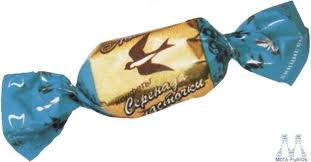
This is almost the same in flavor to the ordinary ласточка, although the label specifies orange extract instead of citrus extract.
The Russians make wonderful candy. The only thing about Russian sweets that makes me scratch my head is their affection for meringue cookies. And those nasty waffle cookies. Hate them.
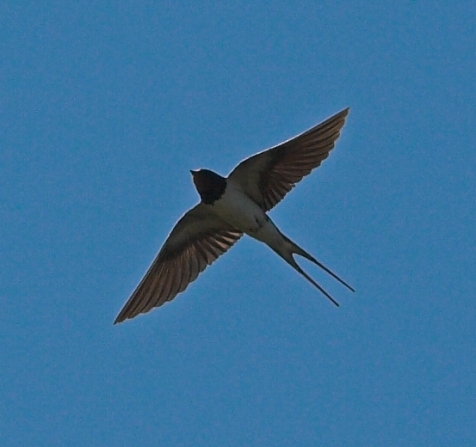
Акварель
Watercolor is Акварель in Russian.The word both means the watercolor paints and an actual watercolor painting. The word theoretically has a plural, but really it's mostly used in the singular.
| Sg | Pl | |
| Nom | акварель | акварели |
| Acc | акварель | акварели |
| Gen | акварели | акварелей |
| Pre | акварели | акварелях |
| Dat | акварели | акварелям |
| Ins | акварелью | акварелями |
| У меня есть акварель. | I have watercolors. |
| Он рисует акварелью. | He paints with watercolors. |
| Научи меня писать акварелью. | Teach me how to paint with watercolors. |
| У неё нет акварели. | She doesn’t have watercolors. |
Акваарель may come from the French word ‘aquarelle.’ Watercolor is a medium of art in the form of painting such as oil painting, charcoal, markers or colored pencils. One of the traits of watercolor is that it appears more transparent than marker or regular paint because it is “relatively pure with less fillers obscuring the color”. There are many different techniques for water-coloring from how you use the paints to how you lay them on the paper and what you do with the paper. Wet on Wet refers to the act of wetting the paper itself and then laying down the watercolor instead of working on a dry surface. Usually the surface used for water color has to be thicker to stand some of the rougher techniques used in watercolor.
As with many forms of art, watercolor can be used in therapy for patients as a way to express their selves if they feel they cannot with words alone, or a way to relieve stress in a positive way. For more information on watercolor such as its history or usage here is where I found most of my information: http://en.wikipedia.org/wiki/Watercolor_painting.

Улица
The Russian word for ‘street’ is улица, which has got to be related somehow to улитка ‘snail,’ but I haven't figured out a way to connect them in an engaging fashion. It is declined like this.
| Sg | Pl | |
| Nom | улица | улицы |
| Acc | улицу | |
| Gen | улицы | улиц |
| Pre | улице | улицах |
| Dat | улицам | |
| Ins | улицей | улицами |
Both Russian streets and American streets can be named after people. So in the US you can have Washington Street or Lincoln Street Street. In Russian when you name a street after someone, the name goes in the genitive case and comes after the word улица. You don't normally capitalize улица, except of course at the beginning of the sentence.
| Где улица Баумана? | Where is Bauman street? |
| Поверните налево на улице Пушкина. | Turn left on Pushkin Street. |
| Как доехать до улицы Михаила Миля? | How do you get to Mikahil Mil street? |
Note that when you translate the street into English, the name must be transliterated from the nominative form, not the genitive form.
Many Russian last names resemble adjectives in form, like Достоевский or Толстой. They must decline like adjectives.
| Как пройти к улице Достоевского? | How do you get to Dostoevski Street? |
| Улица Толстого сегодня закрыта. | Tolstoy Street is closed today. |
Now, what if the name of the street isn't a person's name, say, something like Trade Union Street or Kremlin Street? Then there are a couple of ways to go about it. The first way is to turn the noun into an adjective and put it in front of the noun; of course, the adjective agrees with the noun in gender, number and case.
| Где Профсоюзная улица? | Where is Trade Union Street? |
| Геологический музей находится на Кремлёвской улице. | The geology museum is located on Kremlin Street. |
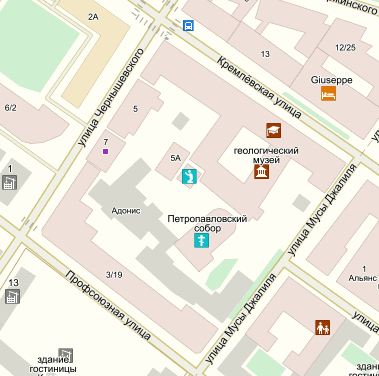
(BTW, I currently really like the map at zurbarzar.ru, and I also love the program 2гис for both maps and linking with reviews.)
Sometimes the adjective will come after the noun, and it will still agree with the noun.
| — Где улица Москвовская? — Что за дурацкий вопрос. Вы на улице Московской и стоите! |
“Where is Moscow Street?” “What a stupid question. You’re standing on Moscow Street!” |
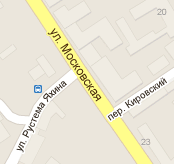
I seem to notice a tendency on internet maps to put the «ул.» in front of the adjective; Google maps seems to have made that editorial decision. However in speech the Russians seem to accept the adjective either before or after the noun... at least I haven't been corrected so far.
<< 1 ... 7 8 9 ...10 ...11 12 13 ...14 ...15 16 17 ... 158 >>